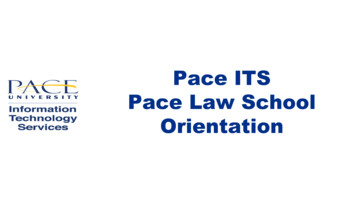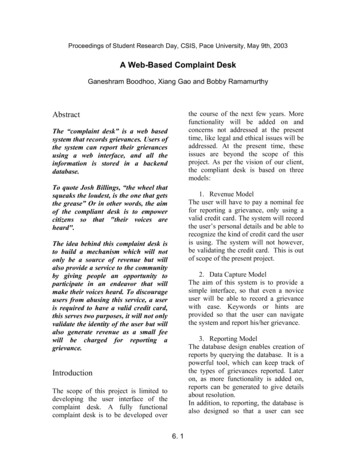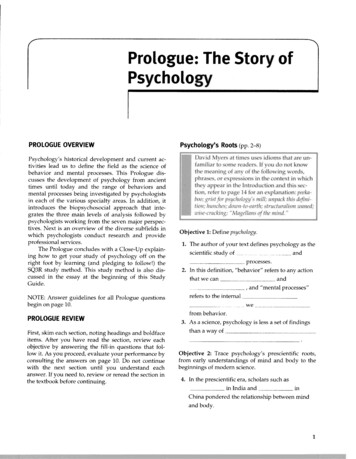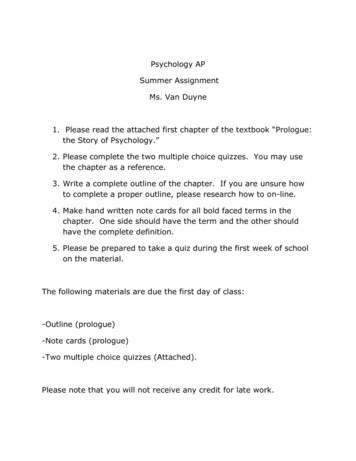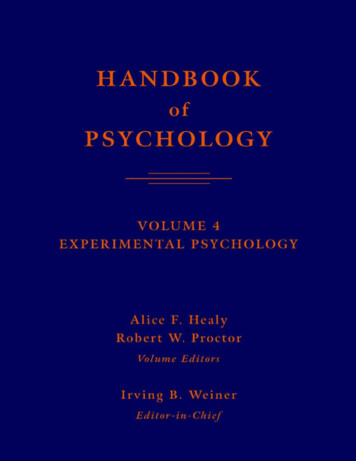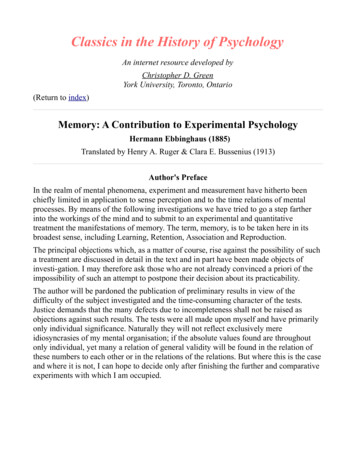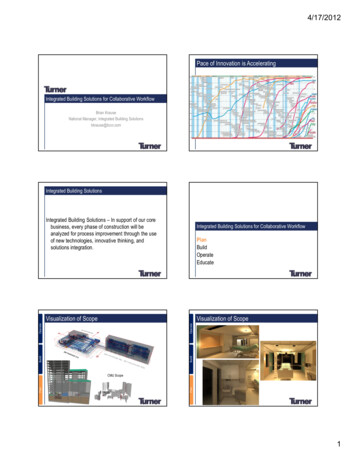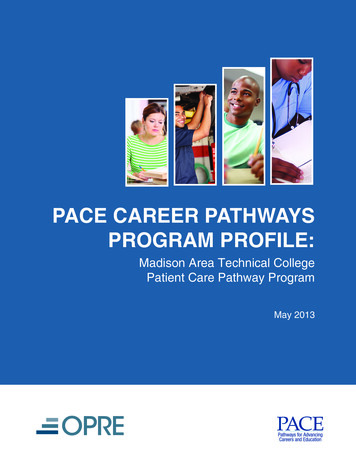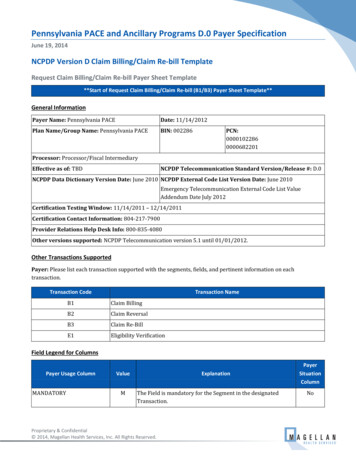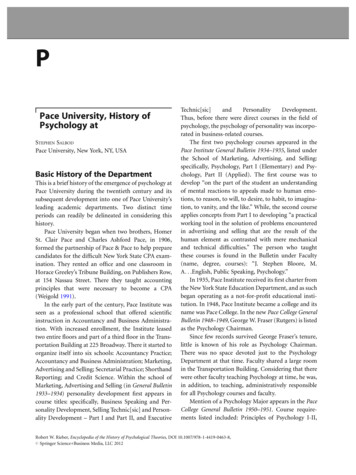
Transcription
PPace University, History ofPsychology atSTEPHEN SALBODPace University, New York, NY, USABasic History of the DepartmentThis is a brief history of the emergence of psychology atPace University during the twentieth century and itssubsequent development into one of Pace University’sleading academic departments. Two distinct timeperiods can readily be delineated in considering thishistory.Pace University began when two brothers, HomerSt. Clair Pace and Charles Ashford Pace, in 1906,formed the partnership of Pace & Pace to help preparecandidates for the difficult New York State CPA examination. They rented an office and one classroom inHorace Greeley’s Tribune Building, on Publishers Row,at 154 Nassau Street. There they taught accountingprinciples that were necessary to become a CPA(Weigold 1991).In the early part of the century, Pace Institute wasseen as a professional school that offered scientificinstruction in Accountancy and Business Administration. With increased enrollment, the Institute leasedtwo entire floors and part of a third floor in the Transportation Building at 225 Broadway. There it started toorganize itself into six schools: Accountancy Practice;Accountancy and Business Administration; Marketing,Advertising and Selling; Secretarial Practice; ShorthandReporting; and Credit Science. Within the school ofMarketing, Advertising and Selling (in General Bulletin1933–1934) personality development first appears incourse titles: specifically, Business Speaking and Personality Development, Selling Technic[sic] and Personality Development – Part I and Part II, and s, before there were direct courses in the field ofpsychology, the psychology of personality was incorporated in business-related courses.The first two psychology courses appeared in thePace Institute General Bulletin 1934–1935, listed underthe School of Marketing, Advertising, and Selling:specifically, Psychology, Part I (Elementary) and Psychology, Part II (Applied). The first course was todevelop “on the part of the student an understandingof mental reactions to appeals made to human emotions, to reason, to will, to desire, to habit, to imagination, to vanity, and the like.” While, the second courseapplies concepts from Part I to developing “a practicalworking tool in the solution of problems encounteredin advertising and selling that are the result of thehuman element as contrasted with mere mechanicaland technical difficulties.” The person who taughtthese courses is found in the Bulletin under Faculty(name, degree, courses): “J. Stephen Bloore, M.A. . .English, Public Speaking, Psychology.”In 1935, Pace Institute received its first charter fromthe New York State Education Department, and as suchbegan operating as a not-for-profit educational institution. In 1948, Pace Institute became a college and itsname was Pace College. In the new Pace College GeneralBulletin 1948–1949, George W. Fraser (Rutgers) is listedas the Psychology Chairman.Since few records survived George Fraser’s tenure,little is known of his role as Psychology Chairman.There was no space devoted just to the PsychologyDepartment at that time. Faculty shared a large roomin the Transportation Building. Considering that therewere other faculty teaching Psychology at time, he was,in addition, to teaching, administratively responsiblefor all Psychology courses and faculty.Mention of a Psychology Major appears in the PaceCollege General Bulletin 1950–1951. Course requirements listed included: Principles of Psychology I-II,Robert W. Rieber, Encyclopedia of the History of Psychological Theories, DOI 10.1007/978-1-4419-0463-8,# Springer Science Business Media, LLC 2012
750PPace University, History of Psychology atTest and Measurements, Child Psychology, AppliedPsychology, Industrial Psychology, Social Psychology,Abnormal Psychology, Human Relations, and MentalHygiene. The Psychology faculty listed were George W.Fraser (Litt.B., Ph.D.), Associate Professor of Psychology, Psychology Chairman; Robert H. DeJorio (B.B.S.)Psychology; Paul Echandia (B.S., M.S., M.A.), AssistantProfessor of English, Speech, Psychology; SeymourLevy (B.S.S.) lecturer in Psychology; and JosephP. Searing, Jr. (B.A.) Psychology. It was at this timethat the Psychology Chairman, George W. Fraser,resigned from his position at Pace College. Administrative responsibilities were then taken over by theSocial Science Department. This ended the first periodof Psychology at Pace University.In 1951, Pace College purchased the New YorkTimes Building at 41 Park Row. In the spring of 1959,students and faculty began using all 16 floors of thebuilding. This space was not sufficient, and in the early1960s Pace College bought 150 Nassau Street (Weigold1991).In 1962 Dr. Thomas J. McShane (Fordham) wasdesignated chairman of a newly formed Departmentof Education and Psychology. He had served as anadjunct faculty member from 1953 to 1958. His background included work with the FBI, from 1941 to 1961,as a polygraphist. Under his leadership, the Psychologymajor became a B.A. degree program in 1963 andproduced its first three graduates in 1966: JerroldNorman Stevens, Allen David Warmbrand, andEdward Jerome Zarow. At this point in time the Schoolof Education was established, the Psychology Department remained under the School of Arts and Sciences,and had its faculty offices located on the ninth floor at150 Nassau Street.The Pace College General Bulletin 1963–1965 givesa glimpse of Psychology as it started in the 1960s. Thecourses offered were: Principles of Psychology, Abnormal Psychology, Psychology of Business and Industry,Psychology of Personal Adjustment, Child Psychology,Psychology of Adolescence, Advertising Psychology(2 points), and Psychology of Learning I and II(2 points each). The faculty who taught them wereThomas J. McShane (Ph.D., Fordham), Professor ofEducation and Psychology, Chairman, Education andPsychology; Paul Echandia (M.S.Ed, Fordham, M.A.,Columbia), Associate Professor of Psychology; MelvinB. Swartz (Ph.D., NYU), Associate Professor of Psychology. Adjunct faculty were Raymond F. Levee(Ph.D., Fordham), Adjunct Assistant Professor of Psychology and Robert C. Oliver (M.A., NYU), AdjunctAssistant Professor of Psychology.In 1969, a chapter of Psi Chi, the National HonorSociety in Psychology was established. Faculty advisorsfor the society have been Drs. Carmine Casella (startdate: February 1969); Thomas McShane (start date:July 1981), Janice Jackson (start date: April 1982), andMercedes McCormick and Florence Denmark (startdate: April 2008).Specialized Psychology Laboratories were createdon the 13th floor of 41 Park Row to meet the needs ofthe nascent department. The Experimental Laboratorywas based on the Fordham University model(Dr. Frances Delahanty (Fordham) personal communication, January 31, 2002). The laboratory consistedof five rooms and 12 cubicles. In addition, a “Rat”Laboratory was created from an unused animal laboratory in the elevator room on the 17th floor (Dr. JohnJ. Mitchell (Catholic U) personal communication,May 11, 2010). In order to analyze data, there wasa calculator laboratory, using Merchant calculators,located on the 11th floor at 41 Park Row.A Psychology Newsletter, Psych Eye, was createdand first published in November 1972. Dr. PaulEchandia (NYU) was the editor. Upon Dr. Echandia’sretirement in 2005, Dr. Richard Velayo (Universityof Michigan) assumed the helm. The latest issue wasVolume 21, no 2.In 1972, a 60-credit M.S.Ed. degree featuring statecertification as a school psychologist became part of thecurriculum. This program was initiated September1973, the year Pace College became Pace University,and graduated its first students in June 1975.In 1979, Pace University became the first universityin New York State to get approval to offer the Doctor ofPsychology (Psy.D.) degree. This new degree wasimplemented during Dr. Thomas McShane’s tenure asDepartment Chairman and represented the hard workand dedication of the full-time faculty: Dr. L. Bart(St. John’s), Dr. C. Casella (Michigan State U),Dr. P. Echandia, Dr. J. Herman (NYU), Dr. J. Jackson(Fordham), Dr. J. Mitchell (Catholic U), Mr. R. Oliver,Dr. M. Swartz, and Dr. I Wentworth-Rohr (NYU). Thefirst two Doctoral Projects were completed in 1982
Pace, Edwardunder the direction of Dr. John J. Mitchell and Dr. JackHerman: Diane W. Bauman and Daniel B. DunnIn the early 1980s, the 13th floor was renovated tocreate office space for psychology faculty and staff. Thisis the final move of the department at the end of thetwentieth century: from the 9th floor at 150 NassauStreet to the 13th floor at 41 Park Row.The Psychological Service Center (Clinic) wasestablished in 1984 on the first floor at 41 Park Row.It was later dedicated to Thomas J. McShane andrenamed The Thomas J. McShane Center for Psychological Services. In 2002 it was moved to the fifth floorat 156 William Street.In 1988, Florence Denmark (University ofPennsylvania) became the first Robert Scott PaceProfessor and Chair of the Psychology Department.She is best known for her research on women’s leadership and leadership styles and the interplay betweenstatus and gender. She has been active in APA leadership for more than 30 years. She served as president ofAPA, ICP, EPA, and NYSPA. It was under her leadershipthat the Psy.D. program received its first accreditationstatus from the American Psychological Association.In 2001, Dr. Herbert Krauss (Northwestern University) became Chair of the New York City PsychologyDepartment. Just as his role as Chair was beginning, thenearby World Trade Center was attacked on September11, 2001. He led the department through December of2009.Today, the New York City Psychology Departmentis part of Dyson College of Arts & Sciences. The department has 13 full-time faculty, 2 part-time faculty, 4 fulltime staff, and adjuncts who support 2 undergraduateprograms: Psychology and Applied Psychology/HumanRelations, and 4 graduate programs: Master of Arts(M.A.) in Psychology, the Master of Science in Education (M.S.Ed.) in School Psychology, the Master ofScience in Education (M.S.Ed.) in Bilingual SchoolPsychology, and Doctor of Psychology (Psy.D.) inSchool-Clinical Child Psychology. In addition, thedepartment offers a BA/MA degree in Psychology.SignificanceOn March 1979, Pace University became the first university in New York State to offer a Doctor of Psychology degree (Psy.D.; Peterson 1992). On November 4,1988 American Psychological Association (APA) gaveP751full accreditation to the Psy.D. with a specialization inSchool-Community Psychology (APA 1989). In 2000,12 years later, the specialization was changed to a combined School-Clinical Child Psychology program and ittoo was fully accredited by APA as a Combined Professional-Scientific Psychology Program (APA 2000).See Also Denmark, Florence L. Fordham University, History of Psychology atReferencesAmerican Psychology Association. (1989). APA-Accredited doctoralprograms in professional psychology: 1989. American Psychologist, 44, 1521–1528.American Psychology Association. (2000). Accredited doctoral programs in professional psychology: 2000. American Psychologist,55, 1473–1488.Peterson, D. R. (1992). The doctor of psychology degree. InD. K. Freedheim (Ed.), History of psychotherapy: A century ofchange (pp. 829–849). Washington, DC: American PsychologicalAssociation.Weigold, M. (1991). Opportunitas: The history of Pace University.New York: Pace University Press.Pace, EdwardJOHN D. HOGANSt. John’s University, Jamaica, NY, USABasic Biographical InformationBorn: July 3, 1861; Died: April 23, 1938.Edward A. Pace was an American theologian andphilosopher who studied with Wilhelm Wundt atLeipzig and returned to the USA to establisha psychology laboratory at the Catholic University ofAmerica, the first at any Catholic university in thecountry. A Catholic priest, Pace was also a member ofthe American Psychological Association in its first yearof existence. Although active as a researcher early in hiscareer, he is best remembered for opening doors to thestudy of psychology by fellow Catholics and for thework of his students, notably Thomas Verner Moore,who was also a Catholic priest.Pace was born in Starke, Florida on July 3, 1861. Hestudied at the Propaganda University in Rome fromP
752PPagès, Robertwhich he received a bachelor’s degree in sacred theology (1883). He was ordained a priest in Rome in 1885,and the following year he received a doctorate in sacredtheology, also from Propaganda University. On hisreturn to the USA, he became the pastor of a churchin St. Augustine, Florida.Pace did not remain as a pastor for long. In 1888, hewas invited to occupy a chair in philosophy at therecently founded Catholic University of America inWashington, DC. While studying in Rome, he hadimpressed his superiors with his quick and agile mindand they remembered him when the new positionbecame available. As preparation for assuming hisnew position, he planned to spend 3 years in additionalstudies at the University of Louvain and in Paris. However, while in Paris, he happened to pick up a book byWundt and was so impressed, he decided he wouldhave to study in Leipzig as well. He entered the programat Leipzig in 1889 and graduated with a doctorate inphilosophy in 1891. His thesis was on the evolutionarytheory of Herbert Spencer. Pace died on April 23, 1938(Misiak and Staudt 1954).Major Accomplishments/ContributionsPace introduced a wide array of psychology-relatedcourses to Catholic University, from traditional laboratory courses to courses in abnormal psychology. Atthe time, these courses were viewed as part of thephilosophy curriculum by the administration. Eventually, however, a separate department of psychology wascreated. In addition to his work at Catholic University,Pace was active in research. He was one of only 13Americans to publish articles in Philosophische Studien,the journal begun by Wilhelm Wundt. In addition tohis doctoral dissertation, Pace published two articles onthe fluctuation of attention there. Other publicationsincluded research on pain perception and binocularvision (Boring 1929).Pace was an ardent supporter of the value of professional meetings. At the very first meeting of theAmerican Psychological Association in 1892, hepresented a paper on “tactile estimates of thickness.”Much of his research underscored his belief in theclose connection between psychology and physiology.He also made an important contribution by defendingthe new scientific psychology against attack by otherCatholics, frequently writing articles for Catholic publications. In fact, his greatest contribution may havebeen to promote psychology and interpret it for hisfellow Catholics (Gillespie 2001).Despite his love for psychology, Pace was active inseveral other areas. In 1893, he was a cofounder ofthe American Philosophical Association, and laterbecame an editor of the 15-volume Catholic Encyclopedia. He also became increasingly drawn to education.In addition, his administrative duties took him furtheraway from psychology. He received many honors during his lifetime. In 1914, he received a papal award fromPope Pius X, and in 1920, he was elevated to the rank ofRight Reverend Monsignor. A testimonial dinner washeld in his honor in 1931, and the presentations werebound into a book to honor him (Ryan 1932).ReferencesBoring, E. G. (1929). A history of experimental psychology. New York:Appleton Century.Gillespie, C. K. (2001). Psychology and American Catholicism.New York: Crossroad Publishing.Misiak, H., & Staudt, V. M. (1954). Catholics in psychology: Anhistorical survey. New York: McGraw-Hill.Ryan, J. H. (1932). Edward Aloysius Pace, philosopher and educator.In C. A. Hart (Ed.), Aspects of the new scholastic philosophy(pp. 1–9). New York: Benziger Brothers.Pagès, RobertMOHAMED ELHAMMOUMICollege of Social Sciences Al-Imam Muhammad IbnSaud University, Riyadh, Saudi ArabiaBasic Biographical Information/Major AccomplishmentsRobert Pagès was a long-standing pillar of the intellectual fabric of social psychology at Sorbonne University.He published dozens of books and monographs andover 670 scientific papers. He was affiliated with theTrotskyite movement and holding egalitarian, anarchist realist ideas which cost him violent reactionsfrom colleagues and state officials. Pagès was the fatherof French social psychology. He promoted social psychology and his influence around the world was
Paranjpe, Anandsignificantly outstanding. He devoted a large space ofhis time to education and mentoring students fromAfrica, South America, and Asia. He believed that education could raise consciousness and overcome social,political, and economical problems that faced developed and developing societies. He was the first toapply experimental methods systematically to thestudy of group processes, social relationships, andpower. His extensive contributions in form of theoryand research marked and shaped the major avenues inwhich French social psychology was to head in laterdecades. Pagès was both a distinguished creative methodologist and innovative theorist. He was heavilyinfluenced by Marx’s writings which affected himthroughout his career as researcher, instructor, andmentor. His career was interrupted by World War IIduring which he was commissioned as a liaison officer.He was a revolutionary leader; during the war he got toknow progressive thinkers. He was the founding fatherof the Laboratory of Social Psychology in the Faculty ofSocial Sciences at Sorbonne University which hedirected from 1952 until his retirement in 1986. Pagèswas given the title of professor of social psychology,taught the first courses ever offered in psychology, andheaded the laboratory after Danielle Lagache. Pagès’experimental work first appeared in 1950 in Bulletinde Psychologie. Social psychology provided a useful setof concepts for research and teaching. In his seminarswhich I attended for 9 years, he stimulated discussionswith such conceptions as emprise (power/control),group processes, social influence, higher mental functions, and macro-social factors.From scratch, he gradually organized his laboratorybased on the following ideas: (1) a rich library andstrong documentation services; (2) teamwork and collaboration between researchers; (3) toward an appropriate social psychology grounded within the culturalhistorical social context of French society; (4) autonomyof social psychology from North American hegemony;(5) the laboratory was the only one of its specialty inFrance; and (6) the laboratory attracted the most brilliant scholars in the field of social psychology. He elaborated a well-defined theory in social psychologyknown as “Theorie d’emprise or Power/control theory”in which he articulated the biological, psychological,and sociological in a unified whole. He developed newconcepts such as noeuds (humans) characterized byP753strong external connections, quasi-noeuds (animals)characterized by strong internal connections, innoeuds(materials or organics), anoeuds (technical or practical), and enoeuds (ideological or religious). He statedthat emprise relations can be possible only betweennoeuds (humans), causal relations between innoeuds(materials or organics). His theory is rich, complex,and promising; due to limited space it is very difficultto do justice to Pagès’ intellectual achievements. Histheory did not make its way to American mainstreampsychology, but it has been well received in Spain, Italy,North Africa, Greece, Switzerland, Canada, Africa,Brazil, and United Kingdom.ReferencesPagès, R. (1957). Recent evolution of theoretical models in socialpsychology. L’Année Psychologique, 57, 121–132.Pagès, R. (1967). Social control: social regulation and power. RevueFrancaise de Sociologie, 8(2), 207–221.Pagès, R. (1979). The establishment of proof and the function of psychology in social psychology. Psychologie Française, 24(
Relations, and 4 graduate programs: Master of Arts (M.A.) in Psychology, the Master of Science in Educa-tion (M.S.Ed.) in School Psychology, the Master of Science in Education (M.S.Ed.) in Bilingual School Psychology, and Doctor of Psychology (Psy.D.) in School-Clinical Child Psychology. In addition, the
